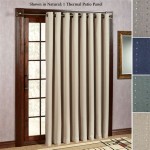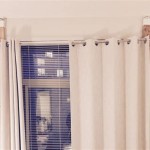Blackout Curtains for Floor-to-Ceiling Windows: Maximizing Light Control and Privacy
Floor-to-ceiling windows offer an unparalleled connection to the outdoors, flooding interior spaces with natural light and providing panoramic views. However, this abundance of light can also lead to glare, overheating, and a lack of privacy. Blackout curtains offer a practical and aesthetically pleasing solution for managing these challenges in spaces with floor-to-ceiling windows. Selecting the right blackout curtains requires careful consideration of various factors, including material, color, style, and hardware. This article will explore the benefits of blackout curtains for floor-to-ceiling windows and provide a guide to choosing the optimal solution for different needs.
The primary function of blackout curtains is to block out external light. This is achieved through the use of tightly woven fabrics and often, a specialized lining. The term "blackout" implies a near-complete reduction in light transmission, creating a darkened environment conducive to sleep, movie viewing, or any activity requiring minimal ambient light. For floor-to-ceiling windows, this is particularly important because the sheer size of the glass pane allows for maximum light entry. Without adequate light control, spaces can become uncomfortably bright, impacting visual comfort and potentially damaging sensitive furnishings over time.
Beyond light control, blackout curtains also contribute to energy efficiency. By blocking sunlight, they reduce heat gain during the summer months, lessening the reliance on air conditioning. Conversely, in the winter, they can help insulate the room by preventing heat from escaping through the windows. This dual functionality can lead to significant cost savings on energy bills. The effectiveness of this insulation depends on the fabric's thickness and density, as well as the quality of the lining.
Another key benefit is enhanced privacy. Floor-to-ceiling windows, while aesthetically appealing, can leave occupants vulnerable to outside observation. Blackout curtains provide a secure barrier, preventing unwanted views into the home or office. This is especially important in urban environments or densely populated areas where privacy is a premium.
Understanding Blackout Curtain Materials
The material composition of blackout curtains is a critical factor in determining their effectiveness. Several materials are commonly used, each with its own set of advantages and disadvantages.
Polyester is a popular choice due to its durability, affordability, and resistance to wrinkles and fading. It is also relatively easy to care for, requiring minimal maintenance. High-quality polyester fabrics, when tightly woven and combined with a blackout lining, can provide excellent light-blocking capabilities. However, polyester may not offer the same level of aesthetic appeal as some natural fibers.
Cotton is another common option, prized for its soft texture and natural appearance. Cotton blackout curtains typically require a specialized lining to achieve full light-blocking performance. The lining is often made of a separate layer of blackout fabric that is sewn onto the back of the cotton curtain. While cotton offers a more luxurious feel than polyester, it is more prone to wrinkles and may require ironing. It can also be more susceptible to fading and shrinking.
Velvet is a luxurious and heavy fabric known for its excellent light absorption and insulating properties. Velvet blackout curtains often do not require a separate lining due to the inherent density of the material. This fabric provides a rich, elegant look and effectively dampens sound, contributing to a quieter environment. However, velvet can be more expensive and requires specialized cleaning to maintain its appearance.
Linen offers a natural, textured look and a breathable quality. Linen alone does not provide adequate blackout capabilities, it requires a blackout lining. Linen is a more sustainable option compared to synthetic materials, but it wrinkles very easily and may require more frequent ironing. It can also be more expensive than polyester.
In addition to the primary fabric, the blackout lining plays a crucial role. Common lining materials include acrylic foam, rubber, and multiple layers of tightly woven fabric. The quality of the lining significantly impacts the overall light-blocking performance of the curtain.
Choosing the Right Style and Color
Blackout curtains are available in a wide range of styles and colors, allowing for seamless integration into various interior design schemes. The choice of style should complement the overall aesthetic of the room and the architectural features of the windows.
Panel curtains are a classic and versatile option, consisting of individual fabric panels that are hung from a rod. They can be easily customized in terms of length, width, and pleating style. Panel curtains are well-suited for both traditional and contemporary spaces. They offer flexibility in terms of light control, allowing for partial or complete closure.
Grommet curtains feature metal rings (grommets) at the top, through which the curtain rod is threaded. This style creates clean, uniform folds and a more modern look. Grommet curtains are easy to install and slide smoothly along the rod. They are often preferred in minimalist or contemporary settings.
Pleated curtains offer a more tailored and formal appearance. Various pleating styles are available, including pinch pleat, goblet pleat, and box pleat. These curtains require more precise measurements and professional installation to achieve the desired effect. Pleated curtains are suitable for more traditional or upscale interiors.
Rod pocket curtains have a sewn-in pocket at the top through which the curtain rod is inserted. This style creates a gathered or ruched effect, offering a more casual and relaxed look. Rod pocket curtains are often easier to install than pleated curtains but may not slide as smoothly along the rod as grommet curtains.
The color of blackout curtains should be carefully considered to complement the existing décor and achieve the desired ambiance. Darker colors, such as navy blue, charcoal gray, and deep brown, are generally more effective at blocking light than lighter colors. However, darker colors can also make a room feel smaller and more enclosed. Lighter colors, such as beige, ivory, and light gray, can help brighten a space while still providing a degree of light control. The specific color choice should be based on the room's intended use and the desired level of light and privacy.
Installation and Hardware Considerations
Proper installation and the selection of appropriate hardware are essential for ensuring the optimal performance and longevity of blackout curtains. The hardware should be strong enough to support the weight of the curtains, especially for floor-to-ceiling windows, which typically require longer and heavier drapes.
Curtain rods are available in various materials, including metal, wood, and plastic. Metal rods are generally the strongest and most durable, making them a good choice for heavy blackout curtains. Wood rods offer a more traditional and decorative look but may not be as strong as metal. Plastic rods are the least expensive option but may not be suitable for very heavy curtains. The diameter of the rod should be sufficient to prevent sagging and ensure smooth sliding of the curtains.
Brackets are used to support the curtain rod and should be securely mounted to the wall. The number and placement of brackets depend on the length of the rod and the weight of the curtains. For floor-to-ceiling windows, it is generally recommended to use multiple brackets spaced evenly along the rod to provide adequate support. The brackets should be made of a sturdy material and securely fastened to the wall studs.
Curtain rings or hooks are used to attach the curtains to the rod. The type of rings or hooks depends on the style of the curtains. Grommet curtains use grommets that slide directly onto the rod. Pleated curtains typically use hooks that are inserted into the pleats and then attached to the rings. Rod pocket curtains do not require rings or hooks, as the rod is inserted directly into the pocket.
For floor-to-ceiling windows, it is important to ensure that the curtains are long enough to reach the floor. The length of the curtains can be customized to achieve different effects. Curtains that puddle slightly on the floor create a more luxurious and dramatic look, while curtains that end just above the floor offer a cleaner and more practical appearance. The ideal length depends on personal preference and the overall style of the room.
Professional installation is often recommended for floor-to-ceiling blackout curtains, especially for pleated styles or complex window configurations. Professional installers have the expertise and tools to ensure that the curtains are properly measured, installed, and adjusted for optimal performance.
In conclusion, blackout curtains for floor-to-ceiling windows offer a multifaceted solution for managing light, enhancing privacy, and improving energy efficiency. The selection of the right material, style, color, and hardware is crucial for achieving the desired results. Careful consideration of these factors will ensure that the blackout curtains not only effectively block out light but also complement the overall aesthetic of the space.

5 Facts When Covering Your Floor To Ceiling Windows

Floor To Ceiling Florida Best Options For Windows

Floor To Ceiling Florida Best Options For Windows

15 Stunning Floor To Ceiling Windows Ideas Sheers Curtains Living Room Interior Design

What To Consider When Ing Floor Ceiling Window Treatments The Shade

Floor To Ceiling Blinds Shades Large Window

15 Stunning Floor To Ceiling Windows Ideas Sliding Glass Door Window Treatments Doors Interior

Floor To Ceiling Blinds Shades Large Window

30 Floor To Ceiling Curtains Frame Your Windows

The Best Blackout Curtains Reviews By Wirecutter








